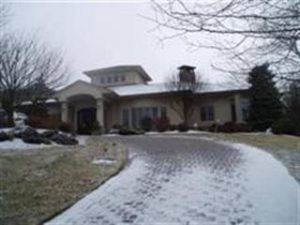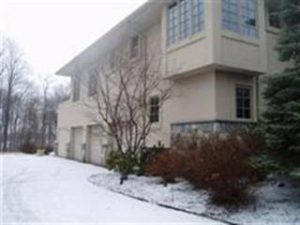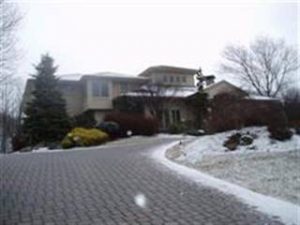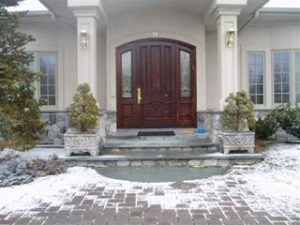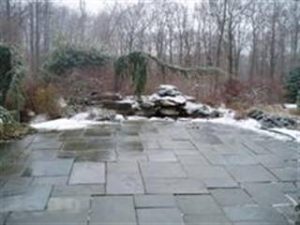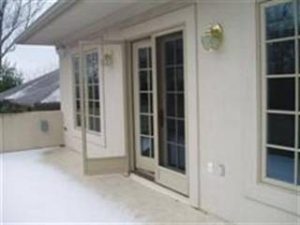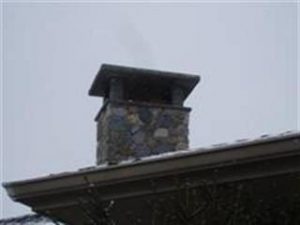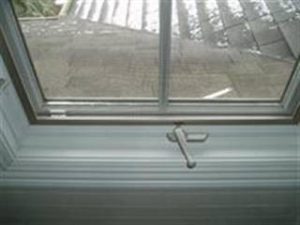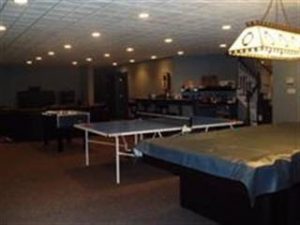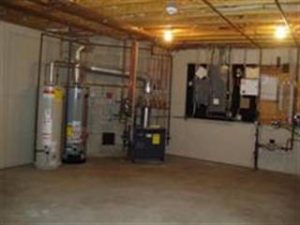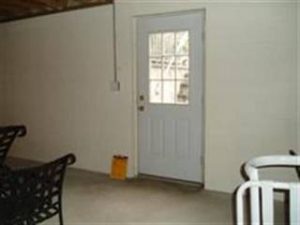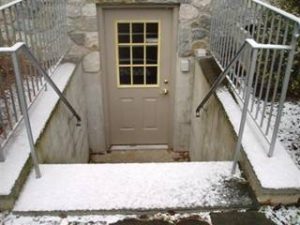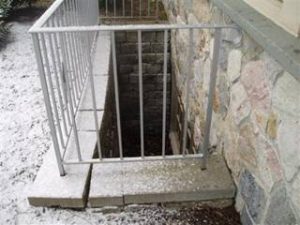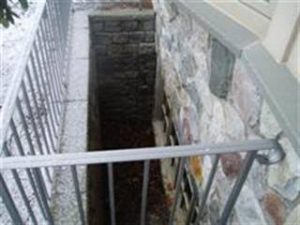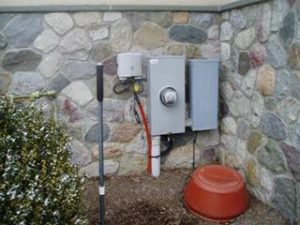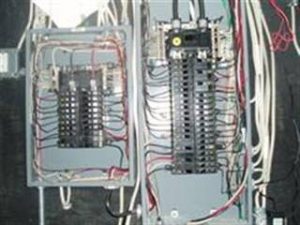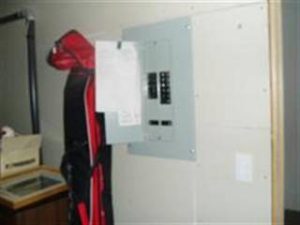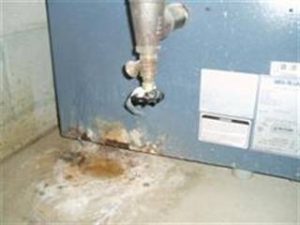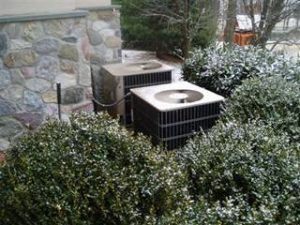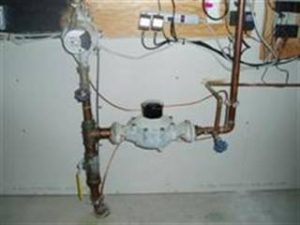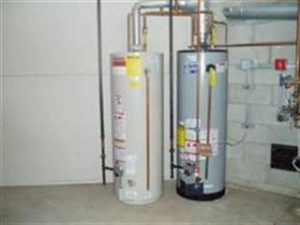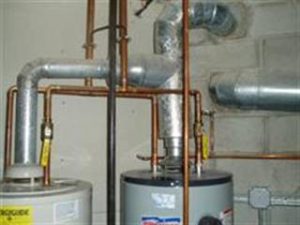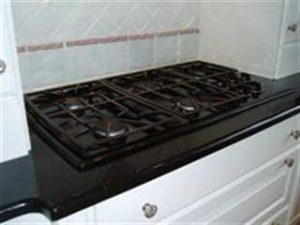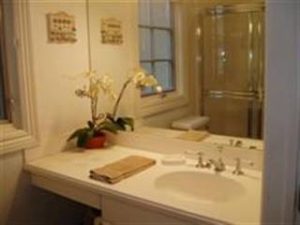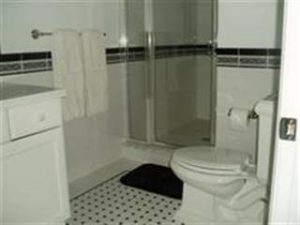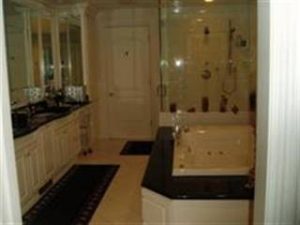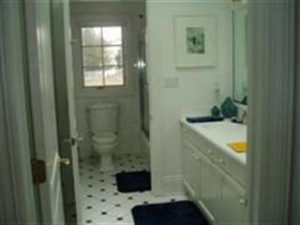All Pro Home Inspections
10 Inwood Place, Maplewood, NJ 07040 (973) 761-0050
Inspector: Ernest Borsellino
NJ Licensed Home Inspector Lic # 24GI00015700
ASHI Certified Member # 094167
H O M E I N S P E C T I O N R E P O R T
| KEY COMMENTS | |
| This key comment page is provided to allow the reader a brief overview of the report. This page is not encompassing. Reading this page alone is not a substitute for reading the report in entirety. Additional explanation of the comments can be found and is encouraged to be read in the main text of this report. | |
| Items felt to be most significant by ALL PRO and/or the client. | |
|
1 The original knob and tube wiring which is now an obsolete practice but still active in this home needs to be checked by a licensed electrician in regard to replacing these older wires. There may be other K&T wiring in the walls and ceilings that could not be seen but will need to be replaced. It should be noted that most insurance companies will not insure homes with Knob and Tube wiring. – The remaining older two-prong outlets cannot be updated to three-prong grounded type, because there is no third ground wire installed and most likely are still connected to the K&T old wiring. – Most likely all the wall lights are connected to the K&T wiring. |
|
| 2. The rust on the cast iron sewer pipe at the front of the basement that is from a leak in the pipe needs repair or replacement. | |
| 3. The open sewer vent pipe in the attic that should have been run through the roof needs to have a mechanical vent | |
| 4. The open electrical wiring for the 3rd floor ceiling light needs to terminate in an electrical box. | |
| 5. The flue pipe for the boiler where it connects to the chimney new lining connector that is missing all the screws and was found to be loose needs to be secured with screws. | |
| 6. The painted closed kitchen exhaust fan louvers on the exterior needs to be loosened to open when the fan is turned on. | |
| 7. The attic bedroom window will need new sash cords for proper operation to keep the window open. One of the 2nd floor bedroom windows also has a broken sash cord. | |
| 8. Interior entrance and closet doors are functional, but most will require adjustment to the strike plates to stay latched closed. | |
| 9. The unground lawn sprinkler system is not checked as part of a home inspection. The home owner needs to be asked of the piping has been blown out for the winter to prevent freezing. | |
| 10. The broken rain sensor for the lawn sprinkler system needs to be replaced. | |
| 11. The reset for the rear right exterior outlet that was tested needs to be located. | |
| 12. The hallway bathroom tub stopper does not work to fill the tub with water. | |
| It is recommended that any deficiencies and the components/systems related to these deficiencies noted in the key comments and/or in the body of the report be evaluated, inspected and repaired as needed by licensed contractors/professionals PRIOR TO THE CLOSE OF ESCROW. | |
EXTERIOR
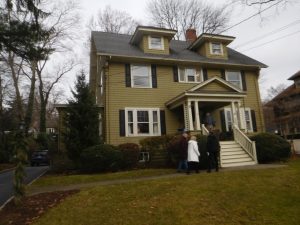

WALKWAYS/STEP
 The front walkway to the main entrance is masonry and is in serviceable condition.
The front walkway to the main entrance is masonry and is in serviceable condition.
The front entrance steps are of wood construction and appears to be structurally sound and in serviceable condition.

The front porch is basically sound structurally. The wood is adequately finished. The surface is pitched away from the home for drainage as original intended during construction.
 The rear entrance steps are of wood construction and appears to be structurally sound and in serviceable condition.
The rear entrance steps are of wood construction and appears to be structurally sound and in serviceable condition.
PATIO
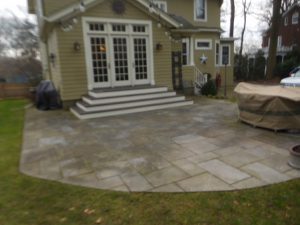
The rear slate patio is in acceptable condition.
DRIVEWAY
The driveway is in serviceable condition. The drainage is adequate away from the home. It is normal for cracks to develop in the surface over time. All open areas should be sealed to prevent water from seeping below the surface. Sealant can be applied every three to four years for aesthetic purposes and may prolong the life of this installation. It keeps ultraviolet rays, gasoline and oil from damaging the surface and it helps prevent water from getting into cracks and breaking up the surface in cold weather. Sealing every year may cause sealer to build up and flake or peel off.
GRADING
The grading around the perimeter of the home looks generally adequate to insure acceptable drainage. Maintaining a positive slope away from the foundation walls will help minimize water accumulation around the building during a rainfall, and help insure a dryer interior. Under no circumstances should wooden portions of the structure be in contact with the ground. Grading in areas away from the building were not comprehensively evaluated in regard to drainage.
OIL TANKS
No testing was performed to locate any underground tanks, such as oil or chemical storage tanks, which might be present, or to determine their condition or legality. The homeowner and the township should be consulted in regard to this matter. A separate company should be hired to scan the property with a metal detector to determine if there are any underground tanks.
ROOF
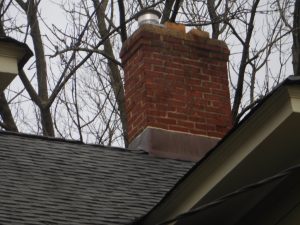 The roof is composed of 15 year old asphalt shingles over the original cedar shingled. A conventional roof of this type has an overall life expectancy in the range of 25-30 years, according to industry standards. This is only an approximation, as many roofs exceed this age, while others require earlier replacement.
The roof is composed of 15 year old asphalt shingles over the original cedar shingled. A conventional roof of this type has an overall life expectancy in the range of 25-30 years, according to industry standards. This is only an approximation, as many roofs exceed this age, while others require earlier replacement.
Protrusions through the roof, such as plumbing vents, skylights, and exhaust ducts are made watertight by “flashings”. These require periodic inspection and must be re-sealed occasionally to keep them watertight.
The roof and chimneys were inspected visually from the ground only. Binoculars were used and portions visible through the windows were evaluated during the interior inspection. These limited inspection methods are due to the inherent danger of climbing on roofs, and the damage which can result to some roofing materials. This type of inspection, together with the attic inspection, usually provides an assessment of the roof’s condition; however, more details can obviously be obtained by a walk-on inspection. If further evaluation is desired or recommended by All Pro, a specialized roofing contractor should be contacted.
CHIMNEY
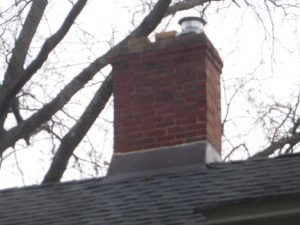 The visible portions of the masonry chimney, appears to be in generally sound condition. The chimney may require repairs to the concrete capping and mortar joints which are exposed to the weather as routine maintenance. The need for maintenance of this type is not apparent from the ground. Water seepage into the masonry will eventually cause deterioration to the flue lining and bricks.
The visible portions of the masonry chimney, appears to be in generally sound condition. The chimney may require repairs to the concrete capping and mortar joints which are exposed to the weather as routine maintenance. The need for maintenance of this type is not apparent from the ground. Water seepage into the masonry will eventually cause deterioration to the flue lining and bricks.
The interior of the flues are not evaluated as part of a standard building inspection. Evaluation of these areas requires a specialized contractor. Rain hood with screens should be installed to keep rain and animals out of the chimney.
The metal flashings that help keep the roof water tight are not visible for evaluation. These areas need to be inspected during heavy rainfall and sealed as required to remain watertight.
GUTTERS/LEADERS
The gutter drainage needs to be checked during rainfall. The purpose of a gutter system is to collect rain and snow from the roof and divert it to leaders away from the home. Debris should be removed to eliminate clogging and overflow. It is recommended that this be done at least twice each year.
The leaders are and should always be diverted away from the foundation walls to decrease the chance of water penetration through the foundations. Leaders that terminate by the foundation wall are one of the main reasons for water seepage into the basement. Debris should be flushed from underground drain pipes to the street and maintained.
SURFACES
SIDING
The wood cedar siding seems to be in overall adequate condition. This type of siding is durable, and will last indefinitely given regular attention. Maintaining the siding is important to preserve a watertight, draft free home.
FASCIAS/SOFFITS/TRIM
The fascias, soffits and trim on the home look to be in adequate condition. The wood for these items are covered in some areas and could not be checked.
Wood surfaces were only probed where accessible from the ground. The rest of the trim should be inspected and caulked and sealed as necessary during other routine maintenance to remain weather tight. Exterior trim components including those around windows and doors, as well as soffits and fascias, are prone to weathering and to openings at the seams and joints that are not evaluated during a home inspection.
DOORS
The entrance door is in operable condition. The hardware is in proper working order. The rear door is operable and in adequate condition. The hardware is in working order.
WINDOWS
The windows have a generally adequate appearance for their age. Only those windows easily accessible for operation were operated. All windows should be operable for exit in case of fire.

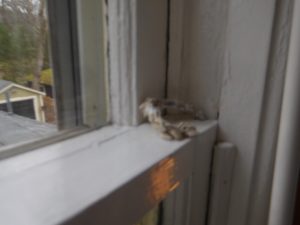
 The attic bedroom window will need new sash cords for proper operation to keep the window open. One of the 2nd floor bedroom windows also has a broken sash cord.
The attic bedroom window will need new sash cords for proper operation to keep the window open. One of the 2nd floor bedroom windows also has a broken sash cord.
2nd floor bedroom window
One of the bedroom windows has a cracked piece of glass.
GARAGE
The walls are in overall adequate condition. The floor is serviceable. The garage door is functional.
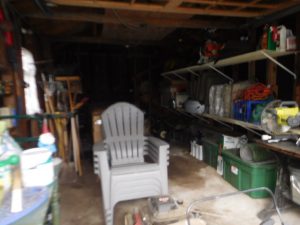
The underground lawn sprinkler system is not checked as part of a home inspection. The home owner needs to be asked of the piping has been blown out for the winter to prevent freezing.
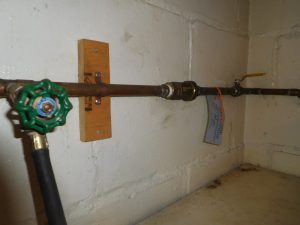
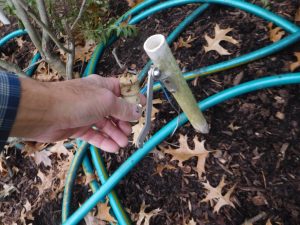
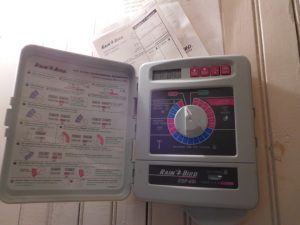
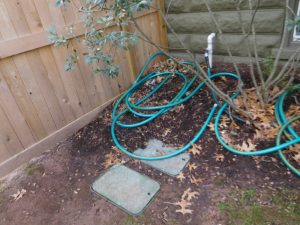
The broken rain sensor for the lawn sprinkler system needs to be replaced.
I N T E R I O R
Carpeting was not lifted to evaluate the condition of the flooring
Furniture was not moved to evaluate outlets and wall conditions.
Cosmetic items in regard to walls, floors and ceilings finish condition are not reported
CRAWLSPACE

The visible portions of the masonry foundation walls and wood walls under the left side family room appear to be in overall sound condition.
BASEMENT
The visible portions of the masonry foundation walls appear to be in overall sound condition.
The foundation walls of the basement could not be comprehensively inspected due to the finished surfaces that have been installed concealing the masonry surface. Mold, signs of water seepage or cracks may be concealed behind the finished surfaces preventing an evaluation of these conditions. The condition of the basement wall structure is excluded from this inspection and report. Finished basement walls can trap moisture behind the surface and promote mold growth. We cannot provide you with an opinion as to the extent of mold that may exist behind finished surfaces or how it should be corrected if mold exist. These conditions can cause health problems and be difficult to correct.
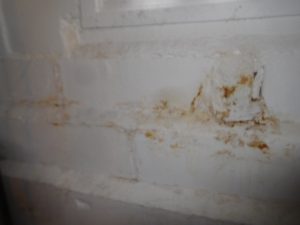 Efflorescence, which is the white powder salt deposit left after water evaporates, is present indicating some amount of water penetration or accumulation. At the time of inspection no water penetration was observed. A prediction in regard to the amount of water penetration that may occur is impossible to determine. It is highly recommended that you contact the present occupants to provide further information concerning any previous incidents of water penetration. It is necessary to occupy a building through the wet seasons prior to assuming that it will be completely dry.
Efflorescence, which is the white powder salt deposit left after water evaporates, is present indicating some amount of water penetration or accumulation. At the time of inspection no water penetration was observed. A prediction in regard to the amount of water penetration that may occur is impossible to determine. It is highly recommended that you contact the present occupants to provide further information concerning any previous incidents of water penetration. It is necessary to occupy a building through the wet seasons prior to assuming that it will be completely dry.
GIRDERS/COLUMNS
The girders (which are the main support beams) are all covered and could not be evaluated.
The columns which support the main girders appear to be in adequate and sound condition.
JOIST/SILL PLATES
The joist and sill plates are all covered with suspended ceiling tiles and could not be evaluated.
A sump, which is a pit in the slab, is located in the basement. An electric pump is provided in the sump to remove water that may accumulate below the home The discharge piping terminates to the exterior away from the building. The pump was manual activated and functioned. Pumps are relatively inexpensive and easy to install. It is advisable to keep a spare pump in case of a failure to the existing one.

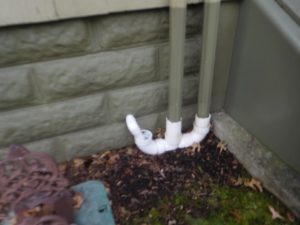
LIVING ROOM
 The living room is in adequate condition. The walls and ceiling appear to be structurally sound. The floor appears to be serviceable.
The living room is in adequate condition. The walls and ceiling appear to be structurally sound. The floor appears to be serviceable.
DINING ROOM
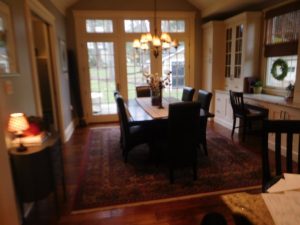 The dining room is in adequate condition. The walls and ceiling appear to be structurally sound. The floor appears to be serviceable.
The dining room is in adequate condition. The walls and ceiling appear to be structurally sound. The floor appears to be serviceable.

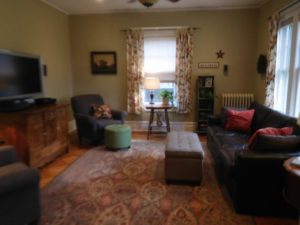 FAMILY ROOM
FAMILY ROOM
The family room is in adequate condition. The walls and ceiling appear to be structurally sound. The floor appears to be 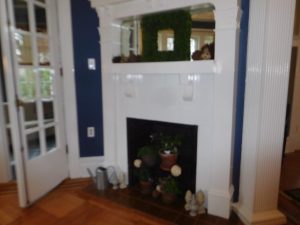 serviceable.
serviceable.
FIREPLACE
The fireplace is not real.
ENTRANCES/HALLWAYS
ENTRANCES
The front entrance area is in adequate condition. The exterior and interior light fixtures are operable.
The rear entrance is also in adequate condition. The exterior light is operable.
HALLWAY
The hallway is in overall adequate condition. The walls and ceiling appear to be structurally sound. The floor is serviceable.
Smoke detectors and carbon monoxide detectors are not inventoried or evaluated during a standard inspection. They are required safety devices and working units should be maintained at the appropriate locations on each level of the home. They should be tested regularly and batteries replaced as required. It is suggested that you check with local fire code officials with regard to any regulations concerning devices of this type.
STAIRS
The stairs appear to be in sound condition. The banister appears to be adequately secured.
BEDROOMS
The bedrooms are in usable condition. The walls and ceilings look to be in adequate condition. Inter The floors are in adequate condition.
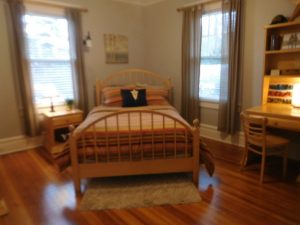


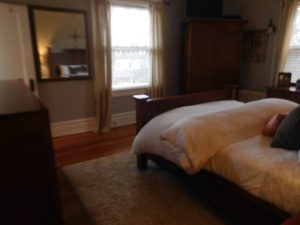
Interior entrance and closet doors are functional, but most will require adjustment to the strike plates to stay latched closed.
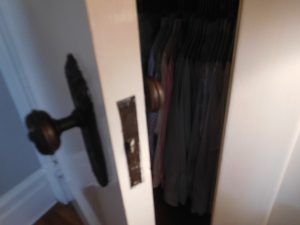

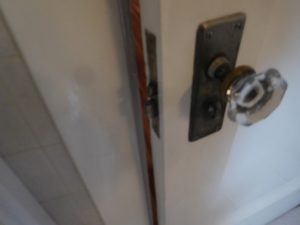
ATTIC
The finished attic areas where visible are thought to be generally adequate. The rafters, joists and sheathing are covered and could not be evaluated.
Ventilation in an attic is very important. It allows moisture that accumulates in this area to dissipate and also helps to reduce the heat buildup that normally develops during the summer months. If the area is inadequately ventilated, this moisture can eventually cause problems such as delaminating roof sheathing.
The wall voids are inaccessible and the amount and type of wall insulation, if any, could not be determined. Present recommended energy efficiency standards call for at least nine inches of insulation above the ceiling. Almost any building, however, will benefit from additional insulation, or other energy saving measures which can result in greater comfort and in reduced utility costs. It is suggested that you consult your utility company or an insulation contractor to determine which energy saving improvements may benefit this building.
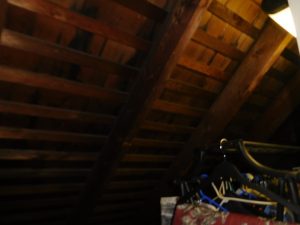
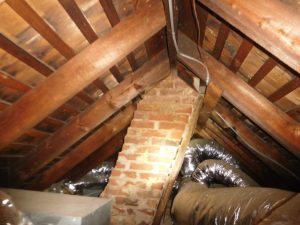
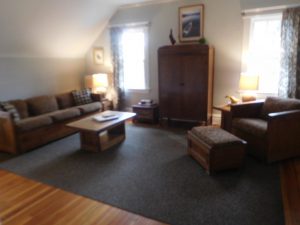
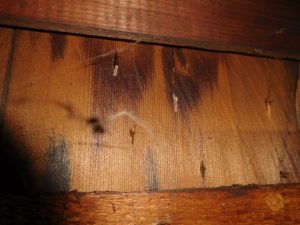
It is very difficult to determine if there is any water penetration during dry weather. Previous water penetration leaves visible stains which do not indicate present leakage but need to be monitored during rainfall. Water penetration through the roof or flashings is dependent on both the weather on the date of inspection and seasonal
ELECTRICAL
The electrical service provided to the building by overhead wires, are securely fastened to the house and there are no noticeable frayed sections. In most communities, this inlet service wire (from the house attachment to the electrical meter) is the responsibility of the homeowner, not the utility company.

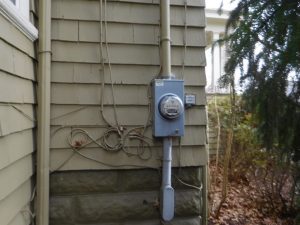 The main service disconnect has a capacity of 200 amperes, 240/120 volt electric service. The main ground where visible appears to be adequately secure. Overcurrent protection is provided by circuit breakers located in a service panel in the basement.
The main service disconnect has a capacity of 200 amperes, 240/120 volt electric service. The main ground where visible appears to be adequately secure. Overcurrent protection is provided by circuit breakers located in a service panel in the basement.
The panels were opened, and branch circuit wiring was found to be copper cable and appears to be in adequate condition.


Only a representative number of outlets, fixtures, and switches were operated. Furniture was not moved to evaluate the amount of outlets per room or condition of the inaccessible outlets.
The reset for the rear right exterior outlet that was tested needs to be located. Ground Fault Circuit Interrupter (GFCI) electrical outlets and breakers are a significant safety improvement and are required for bathrooms, kitchen counter top outlets, garages, crawlspaces, unfinished basements, outside outlets, etc. to reduce potential electrical hazards in wet areas.
The original knob and tube wiring which is now an obsolete practice but still active in this home needs to be checked by a licensed electrician in regard to replacing these older wires. There may be other K&T wiring in the walls and ceilings that could not be seen but will need to be replaced. It should be noted that most insurance companies will not insure homes with Knob and Tube wiring.
Attic Basement
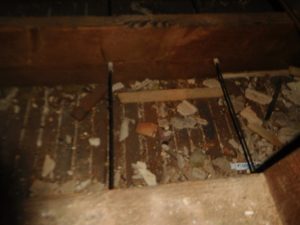

The remaining older two-prong outlets cannot be updated to three-prong grounded type, because there is no third ground wire installed and most likely are still connected to the K&T old wiring.
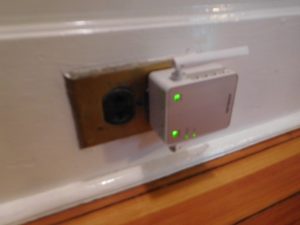
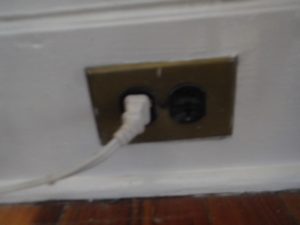
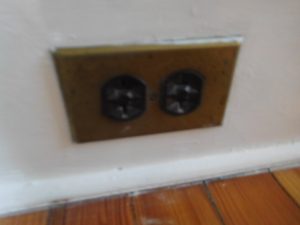
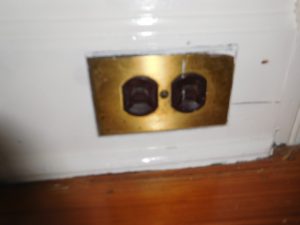
 The open electrical wiring for the 3rd floor ceiling light needs to
The open electrical wiring for the 3rd floor ceiling light needs to 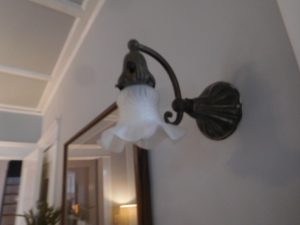 terminate in an electrical box.
terminate in an electrical box.
Most likely all the wall lights are connected to the K&T wiring.
HEATING
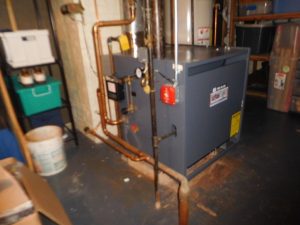 Heat is provided by a 2012 gas-fired, steam boiler. The normal life expectancy for a boiler is in the vicinity of 30 to 40 years prior to the need for replacement.
Heat is provided by a 2012 gas-fired, steam boiler. The normal life expectancy for a boiler is in the vicinity of 30 to 40 years prior to the need for replacement.
The burner ignited and operated smoothly. The unit was operated only for a short period of time during the inspection. The radiators did not get hot enough to fully evaluate each one. Leaks may be present at the radiator valves and air vents that could not be checked at this time. A steam system requires occasional maintenance to individual radiator shut-off valves and air vents to balance the system for equal distribution of the system to each radiator. It is advisable to check this unit and the radiators when temperature conditions require the unit to be run for a longer period of time.
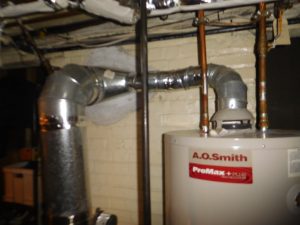 The flue pipe for the boiler where it connects to the chimney new lining connector that is missing all the screws and was found to be loose needs to be secured with screws.
The flue pipe for the boiler where it connects to the chimney new lining connector that is missing all the screws and was found to be loose needs to be secured with screws.
The low water cut off switch should be checked periodically to ensure it is operating properly to prevent the boiler from cracking. The water level must be maintained within the limits of the sight gage on the unit. The water should be drained periodically to remove sediment and insure reliable operation. The boiler can crack and require replacement if the water runs out and the low water cutoff switch does not shut down the unit.
The heating unit was operated only for a short period of time during the inspection. During a single inspection it is impossible to determine how adequately this heating system will heat this home. It is recommended that the system be inspected, cleaned and maintained by service personnel to insure reliable and efficient operation.
CENTRAL AIR CONDITIONING
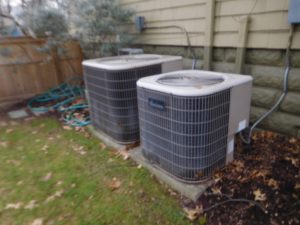 This home also features two 2003 central air conditioning systems. These units could not be fully evaluated at this time due to low temperature conditions. It is recommended that the units be checked before taking possession of the home if at all possible.
This home also features two 2003 central air conditioning systems. These units could not be fully evaluated at this time due to low temperature conditions. It is recommended that the units be checked before taking possession of the home if at all possible.
The 2003 condenser units located outside the home was inspected externally. Units of this type have an average life expectancy of approximately 15 years. The compressor units can be damaged unnecessarily by operating it below design temperatures, and therefore they were not activated. The insulation on the refrigerant lines, where visible, is adequately installed.
Attic Basement
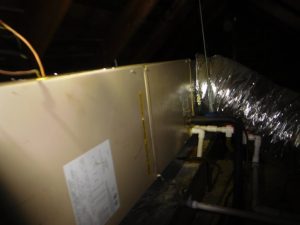
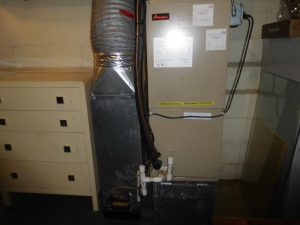
PLUMBING
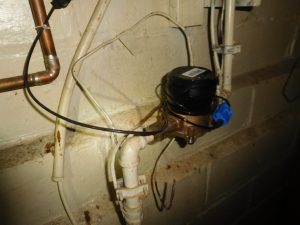 Water appears to be provided by a municipal source. The main water line to the house from the street shutoff valve to the water meter is copper and in serviceable condition. It is advisable to obtain insurance on this pipe and the sewer line if available.
Water appears to be provided by a municipal source. The main water line to the house from the street shutoff valve to the water meter is copper and in serviceable condition. It is advisable to obtain insurance on this pipe and the sewer line if available.
The copper water distribution lines appear to be in generally leak free condition. Water pressure is thought to be basically adequate and functional flow was noted where evaluated.
 The rust on the cast iron sewer pipe at the front of the basement that is from a leak in the pipe needs repair or replacement.
The rust on the cast iron sewer pipe at the front of the basement that is from a leak in the pipe needs repair or replacement.
The sewer line from the street to the home can not be checked. This requires the use of a video camera which is not part of a home inspection evaluation. The interior visible sections of the sewer lines look adequately sloped to provide proper drainage. Vents are noted through the roof to help facilitate water flow in these drain lines.
Most of the piping in the home is concealed inside walls and ceilings and could not be visually inspected. Shut off valves other than the fixtures themselves were not operated because they are operated infrequently and often leak after use.
Laundry appliances are not evaluated within the scope of a home inspection.
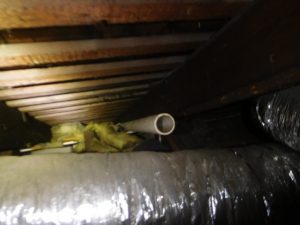 The open sewer vent pipe in the attic that should have been run through the roof needs to have a mechanical vent
The open sewer vent pipe in the attic that should have been run through the roof needs to have a mechanical vent
WATER HEATER
Hot water is provided by a 2009, 40 gallon, gas-fired unit. Units of this type have a normal life expectancy of 10-15 years. The exhaust system appears to be a proper installation. A relief valve is installed on this unit to protect against high temperature and pressure. The discharge pipe on
the relief valve should always be diverted just above the floor for safety. The piping installation appears to be in adequate condition. No indication of leakage was observed.
KITCHEN
The walls and ceiling are in adequate condition. The floor surface has an overall serviceable appearance. The cabinets and counter tops look basically functional. The faucet, sink and drain line appear to be in generally leak free condition.
DISHWASHERS
The dishwashers were placed through a short cycle and functioned without any visible leaks.
The oven and burners were functional. The other major appliances operated, and appeared to be functional.
Only the built-in appliances are regularly evaluated as part of an All Pro inspection. This does not include the refrigerator. Based on these limitations, All Pro cannot provide any warranties beyond those issued by the manufacturer and cannot predict the useful life of the appliances. It is recommended that you obtain the manufacturer’s informational booklets and warranties, if available.
The painted closed kitchen exhaust fan louvers on the exterior needs to be loosened to open when the fan is turned on.
The garbage disposal operated.
BATHROOM(S)
The bathrooms are in overall adequate condition. The floor and walls outside the bathtub enclosures appear to be in acceptable condition. The tubs and enclosure surfaces appear to be in adequate condition. Surfaces subjected to wet conditions should be well caulked, grouted and sealed as necessary to maintain them in a waterproof condition. This is important maintenance and will help to prevent leaks and deterioration of the materials behind these surfaces.
The fixtures are operable and appear to be in leak-free condition. The toilets are adequately secured and function satisfactorily. The lights and receptacles are functional. Water temperature and pressure is felt to be adequate.
The water in the shower stall was run for quite a few minutes and no leakage was observed as evidence by any visible water stains on the surfaces below. A metal pan is normally installed below the tile floor. This eventually corrodes and can develop leaks if not maintained, however, it is apparently in leak-free condition at this time.
1st floor half bathroom
The hallway bathroom tub stopper does not work to fill the tub with water.
No picture of attic bathroom
bedroom bathroom
Basement toilet
End of report.



